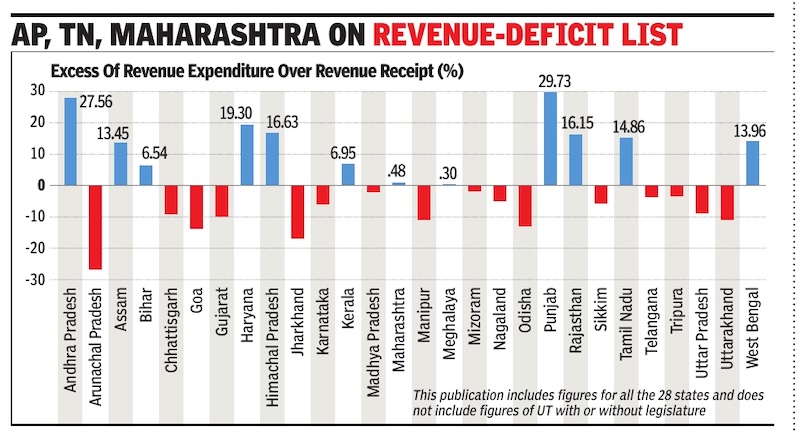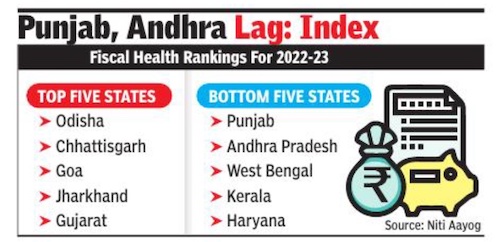State governments' finances: India
This page was earlier known as “Government finances: India.” All data that pertains only to the finances of the Government of India Has been shifted to the page Government of India's finances
This is a collection of articles archived for the excellence of their content. |
Contents |
Capital expenditure of central and state governments
2012-21

From: Dec 8, 2021: The Times of India
See graphic:
Centre & states' capex (as % of GDP)- FY12-FY22
States’ Capex Spends Double In First Half Of Current Fiscal
In the 2021 Budget, the Centre announced a strong capex push (2. 5% of GDP, the highest since FY08, versus 1. 7% pre-pandemic). According to finance statements of 28 states, capex may increase to 3% of GDP in FY22. In the same period last year, while that of the Centre is moving in line with Budget estimate. (Source: CEIC, govt, UBS)
2023, April to September

From: Nov 21, 2023: The Times of India
See graphic:
The capital expenditure of the central government and state governments in 2023, April to September
Debt to Gross State Domestic Product (GSDP) ratio
2012-2023
February 13, 2025: The Times of India

From: February 13, 2025: The Times of India
New Delhi : Just four states — Gujarat, Odisha, West Bengal and Maharashtra — have managed to lower the debt to gross state domestic product (GSDP) ratio, while Punjab and Tamil Nadu have been the worst performing, seeing the steepest increase, according to a new paper by economists.
The paper by NCAER economist Barry Eichengreen and the agency’s chief Poonam Gupta, who is also part of the advisory council to the 16th Finance Commission, has estimated that Punjab and, possibly, Rajasthan’s debt-GSDP level could cross 50% by 2027-28, underlying the need for focused action. It has proposed a relook at the role of the Finance Commission itself. “…Finance Commissions have not been asked to consider overall fiscal prudence when recommending allocations. The horizontal devolution (state-wise) of taxes among states… does not provide incentives for fiscal rectitude. Perversely, Finance Commissions are mandated to allocate more resources to states with larger revenue deficits, which is an obvious source of moral hazard and a mechanism through which errant states are subsidised,” it said.
The recommendations come at a time when political parties are doling out freebies and subsidies across states, which already have committed expenditure towards salary and pension and interest payment that are difficult to reduce.
Pointing to the room for a fiscal “grand bargain”, the paper has suggested that heavily indebted states with the worst prospects could be given a modicum of debt relief in return for their conceding additional Central govt oversight and even a temporary dilution of fiscal autonomy.
States account for nearly a third of the overall debt with the Centre accounting for the rest. The paper has advocated the setting up of independent fiscal councils in the states to assess the realism of spending and revenue projections.
Besides, the economists have recommended a forensic analysis identifying the specific revenue shortfalls or expenditure overruns resulting in excessive budget deficits and debt increases in the fiscally worst performing states. They have also said that states need to improve revenue mobilisation through digitalisation and administrative streamlining, by broadening the tax base, raising property tax, and adopting new taxes, and by increasing privatisation receipts while re-orienting spending toward capacity and infrastructure-enhancing investment.
Market borrowings by states
2020/ Q2

From: July 30, 2020: The Times of India
See graphic:
Market borrowings by Indian states, 2020/ Q2
Revenues and expenditures
2023
Pradeep Thakur, Sep 22, 2025: The Times of India

From: Pradeep Thakur, Sep 22, 2025: The Times of India
New Delhi : Federal auditor CAG, in a first of its kind report on state finances — a decadal study on economic performance of states — has found that 16 states are revenue surplus.
Surprisingly, leading them is Uttar Pradesh — once clubbed as a prominent member of Bimaru states — with Rs 37,000 crore surplus in the fiscal year 2023. In fact, UP is joined in the elite club by Madhya Pradesh, another member of the erstwhile sick states, with more revenue receipts than expenditure.
UP is followed by Gujarat (Rs 19,865 crore), Odisha (Rs 19,456 crore), Jharkhand (Rs 13,564 crore), Karnataka (Rs 13,496 crore), Chhattisgarh (Rs 8,592 crore), Telangana (Rs 5,944 crore), Uttarakhand (Rs 5,310 crore), Madhya Pradesh (Rs 4,091 crore) and Goa (Rs 2,399 crore).
The northeastern states of Arunachal, Manipur, Mizoram, Nagaland, Tripura and Sikkim are also among the states on this coveted list. Of the 16 states with revenue surplus, at least 10 are led by BJP.
The report, released on Friday by CAG Sanjay Murthy, found that in 2022-23, at least 12 states were in revenue deficit. These included Andhra Pradesh (-Rs 43,488 crore), Tamil Nadu (-Rs 36,215 crore), Rajasthan (-Rs 31,491 crore), West Bengal (-Rs 27,295 crore), Punjab (-Rs 26,045 crore), Haryana (-Rs 17,212 crore), Assam (-Rs 12,072 crore), Bihar (-Rs 11,288 crore), Himachal Pradesh (-Rs 6,336 crore), Kerala (-Rs 9,226 crore), Maharashtra (-Rs 1,936 crore) and Meghalaya (-Rs 44 crore).
The composition of revenue deficit states is fast changing with West Bengal, Kerala, Himachal Pradesh and Punjab joining the league of those surviving on Revenue Deficit Grants from the Centre.
West Bengal received the largest share of 16% grants in FY 2023 to bridge the gap between its revenue receipts and expenditure, followed by Kerala 15%, Andhra Pradesh 12%, Himachal Pradesh 11%, and Punjab 10%, CAG said.
At the same time, there are states that have boosted their own revenue sources, both tax and non-tax. Haryana tops this list, having the highest own tax and non-tax revenue of over 80% of the state’s total revenue. (The other revenue a state receives is through central taxes and grants). Telangana is second with over 79% of its own revenue, followed by Maharashtra 73%, Gujarat 72%, Karnataka 69%, TN 69% and Goa 68%.
“In 2022-23, six states: Haryana, Maharashtra, Telangana, Karnataka, Gujarat and TN had States’ Own Tax Revenue (SOTR) of more than 60% of their total revenue receipts. Arunachal, Manipur, Meghalaya, Mizoram, Nagaland, Sikkim & Tripura had SOTR of less than 20%,” CAG noted.
The share in Union taxes and grants-in-aid and central assistance, including finance commission grants, constituted 27% and about 17%, respectively, of the states’ revenue receipts. States received a total of Rs 1,72,849 crore as finance commission grants, of which Rs 86,201 crore was Revenue Deficit Grants.
The own revenue receipts of Karnataka, TN, Goa and Kerala are in the range of 60%-70%; and Andhra, Rajasthan, Punjab and Chhattisgarh between 50% to 60%. The revenue receipts of Jharkhand, Madhya Pradesh, UP, West Bengal and Uttarakhand are between 40%-50%. “The share of states’ own tax and non-tax revenue in revenue receipts of all eight northeastern states, and Bihar and Himachal Pradesh were below 40%,” CAG said.
Among the various streams of states own revenue, a large collection comes from States’ Goods and Services Tax (SGST) as well as from VAT and excise duty on alcoholic drinks, petroleum products and electricity (which are outside the GST framework).
State governments
Extent of control of finances
2024

From: January 2, 2025: The Times of India
See graphic:
The extent of control of state governments over their finances, presumably as in 2024
State governments: Fiscal Health Index
2022- 2023
January 25, 2025: The Times of India

From: January 25, 2025: The Times of India
New Delhi : Odisha, Chhattisgarh, Goa, Jharkhand and Gujarat have emerged as the top performing states in the fiscal health index, compiled by govt think tank Niti Aayog.
Punjab, Andhra Pradesh, West Bengal, Kerala and Haryana figure at the bottom of the table. The performance of the states have been put under four categories — achievers, front runners, performers and aspirational. Odisha, Chhattisgarh, Goa, Jharkhand and Gujarat are achievers, with higher capital outlay, effective mobilisation of non-tax revenue, creation of revenue surpluses, low interest payments. States under the aspirational category include Kerala, West Bengal, Andhra Pradesh and Punjab. The states under the aspirational category are struggling to meet the fiscal and revenue deficit targets, have low revenue mobilisation and are faced with growing debt burden, and debt sustainability is a concern.
The states’ performance varies across the five sub-categories. For instance, Uttar Pradesh and Bihar have a good score under quality of expenditure but they rank lower with regard to revenue mobilisation, Karnataka has performed well across most indices but it ranks among the three bottom states in terms of debt sustainability. Odisha and Chhattisgarh have performed well under revenue mobilisation category with their own non-tax revenue growing significantly due to high revenue collection from mining. But on debt sustaina- bility, Chhattisgarh ranks lower compared to other states.
The Fiscal Health Index (FHI) is aimed at evolving an understanding of the fiscal health of states in the country. The analysis covers eighteen major states that drive the country’s economy in terms of their contribution to GDP, demography, total public expenditure, revenues, and overall fiscal stability. “As states are responsible for approximately two-thirds of public spending and one third of total revenue, their fiscal performance is important for the country’s overall economic stability,” according to the report. It further adds that the objective is to evaluate fiscal health of the states through key fiscal parameters, identify fiscal strengths and weaknesses.
See also
State governments' finances: India